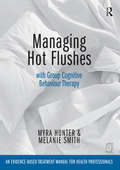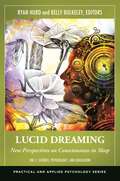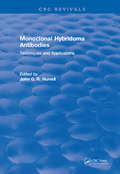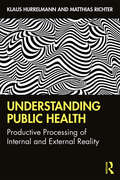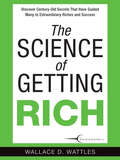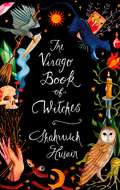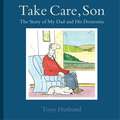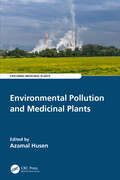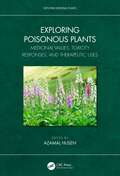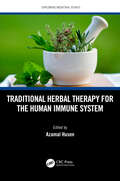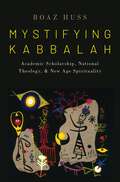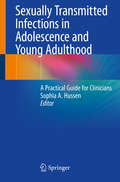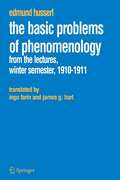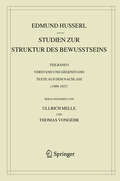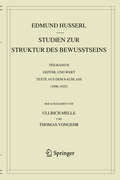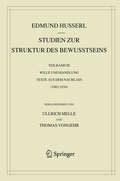- Table View
- List View
Managing Hot Flushes with Group Cognitive Behaviour Therapy: An evidence-based treatment manual for health professionals
by Myra Hunter Melanie SmithFollowing the success of Managing Hot Flushes and Night Sweats which outlines a self-help, CBT-based programme for dealing with menopausal symptoms, Myra Hunter and Melanie Smith have developed a pioneering group treatment for women going through the menopause. Managing Hot Flushes with Group Cognitive Behaviour Therapy is an evidence-based manual drawing on their research which has demonstrated, in randomised controlled trials, that group CBT effectively reduces the impact of hot flushes and night sweats. The treatment is effective for women going through a natural menopause and for women who have menopausal symptoms following breast cancer treatments and for other groups of women who have troublesome symptoms. This manual provides health professionals with everything they need to run groups to help women to manage hot flushes and night sweats. Managing Hot Flushes with Group Cognitive Behaviour Therapy equips health professionals with knowledge, skills and materials to run groups to help women to manage menopausal symptoms in 6 (or 4) weekly sessions without the need for medication. It is easy to use with a companion audio exercise and downloadable/photocopiable resources on line, as well as power-point slides, homework sheets and diaries. Following Group CBT women have the information, practical skills and strategies to help them to cope with hot flushes and night sweats, and also report improvements in sleep and quality of life. This manual will be an essential resource for nurses, psychologists, counsellors, psychological wellbeing practitioners and cognitive behaviour therapists working in health care and voluntary settings.
Managing Hot Flushes with Group Cognitive Behaviour Therapy: An evidence-based treatment manual for health professionals
by Myra Hunter Melanie SmithFollowing the success of Managing Hot Flushes and Night Sweats which outlines a self-help, CBT-based programme for dealing with menopausal symptoms, Myra Hunter and Melanie Smith have developed a pioneering group treatment for women going through the menopause. Managing Hot Flushes with Group Cognitive Behaviour Therapy is an evidence-based manual drawing on their research which has demonstrated, in randomised controlled trials, that group CBT effectively reduces the impact of hot flushes and night sweats. The treatment is effective for women going through a natural menopause and for women who have menopausal symptoms following breast cancer treatments and for other groups of women who have troublesome symptoms. This manual provides health professionals with everything they need to run groups to help women to manage hot flushes and night sweats. Managing Hot Flushes with Group Cognitive Behaviour Therapy equips health professionals with knowledge, skills and materials to run groups to help women to manage menopausal symptoms in 6 (or 4) weekly sessions without the need for medication. It is easy to use with a companion audio exercise and downloadable/photocopiable resources on line, as well as power-point slides, homework sheets and diaries. Following Group CBT women have the information, practical skills and strategies to help them to cope with hot flushes and night sweats, and also report improvements in sleep and quality of life. This manual will be an essential resource for nurses, psychologists, counsellors, psychological wellbeing practitioners and cognitive behaviour therapists working in health care and voluntary settings.
Lucid Dreaming [2 volumes]: New Perspectives on Consciousness in Sleep [2 volumes] (Practical and Applied Psychology)
by Ryan Hurd Kelly Bulkeley Jorge Conesa-Sevilla Daniel Erlacher Jayne Gackenbach Brigitte Holzinger David J. Hufford Harry T. Hunt Lee Irwin Stephen Laberge James F. Pagel Tim Post G. Scott Sparrow Tadas Stumbrys Isaac Y. Taitz Georg Voss Ursula Voss Robert Waggoner Mary ZiemerIn this fascinating new collection, an all-star team of researchers explores lucid dreaming not only as consciousness during sleep but also as a powerful ability cultivated by artists, scientists, and shamans alike to achieve a variety of purposes and outcomes in the dream.The first set of its kind, Lucid Dreaming: New Perspectives on Consciousness in Sleep provides a comprehensive showcase of the theories, research, and direct experience that serve to illuminate how certain people can maintain conscious awareness while dreaming. The text is organized into two sections, covering science, psychology, and education; and religious traditions, creativity, and culture. Contributors to this two-volume work include top dream experts across the globe—scholars sharing knowledge gained from deep personal explorations and cutting-edge scientific investigations.Topics covered include the neuroscience of lucid dreaming, clinical uses of lucid dreaming in treating trauma, the secret history of lucid dreaming in English philosophy, and spiritual practices of lucid dreaming in Islam, Buddhism, and shamanic traditions. The work also addresses lucid dreaming in movies including The Matrix and literature such as the fiction of J.R.R. Tolkien and explains how modern video gaming enhances lucidity. This set serves as an ideal text and reference work for school libraries and academic courses in anthropology, psychology, religious studies, and cognitive science as well as for graduate-level study in holistic education—an increasingly popular specialization.
Monoclonal Hybridoma Antibodies: Techniques and Applications
by John G.R. HurrellThe first section of this volume is aimed to provide a comprehensive review of the many varied and often empirically derived techniques and procedures currently in use to produce monoclonal hybridoma cell lines and to characterize the antibodies secreted. The goal has been achieved with the chapter contributed by Zola and Brookes who, as each step in the process of hybridoma production and antibody characterisation is reviewed, have provided an experimental procedure found to be satisfactory in their laboratory.The second section of this volume is designed to provide a review of areas in which monoclonal hybridoma antibodies have been of particular advantage. This is a rapidly advancing field which could not be thoroughly reviewed in a single volume.
Monoclonal Hybridoma Antibodies: Techniques and Applications
by John G.R. HurrellThe first section of this volume is aimed to provide a comprehensive review of the many varied and often empirically derived techniques and procedures currently in use to produce monoclonal hybridoma cell lines and to characterize the antibodies secreted. The goal has been achieved with the chapter contributed by Zola and Brookes who, as each step in the process of hybridoma production and antibody characterisation is reviewed, have provided an experimental procedure found to be satisfactory in their laboratory.The second section of this volume is designed to provide a review of areas in which monoclonal hybridoma antibodies have been of particular advantage. This is a rapidly advancing field which could not be thoroughly reviewed in a single volume.
The Little Book of Witchcraft: An Introduction to Magick and White Witchcraft
by Judith HurrellDiscover the wonders of Wicca and learn how to harness your inner power with this beginner’s guide to white witchcraftFind your magick From the history of Wicca to the basics of spell work, this pocket-sized book is the perfect introduction to magick and white witchcraft. Find out how to tap into the infinite power of the natural world by uncovering the unique properties of natural ingredients – from herbs, flowers and seeds to incense and crystals. Study the extraordinary history of witches and Wicca, and discover how present-day witches combine modern technology and traditional methods to help manifest their desires. Master the rudiments of white magick with enchantments and rituals for every occasion.Whether you’re a budding witch or simply want to learn more about the world of spells and sorcery, this book includes everything you need to understand and start practising this remarkable craft.Enrich your life with the power of magick and learn how to:Uncover and embrace your inner witchConnect with the rich history of witchcraftStart developing your Wiccan abilities and sustain your craftWork in alignment with the earth’s natural rhythms to get the most out of your practiceCreate spells, potions and rituals for promoting love, happiness and success
Understanding Public Health: Productive Processing of Internal and External Reality
by Klaus Hurrelmann Matthias RichterThis book develops a new model of the genesis of health, on the basis of the interplay between genetic and environmental factors. Hurrelmann and Richter build upon the basic theories of health and the popular model of salutogenesis to offer a comprehensive interdisciplinary theory of health genesis and success: Productive Processing of Reality (PPR). The authors show that health is the lifelong dynamic process of dealing with the internal reality of physical and psychological impulses and the external reality of social and material impulses. To demonstrate this, the book is split into three interconnected parts. Part A analyses the determinants of health, providing an overview of the insights of current research and the impact of socioeconomic influences and gender on health. Part B covers public health, social, learning and coping theories, all of which understand health as an interaction between people and their environment. Part C draws on these four theories to outline PPR, stressing the interrelation between physical and mental constitution and the demands of the social and mental environment, and suggesting strategies for coping with these demands during the life course. Understanding Public Health: Productive Processing of Internal and External Reality will be valuable reading for students and researchers in psychology, sociology, educational science, public health and medical science, and for policymakers in public health.
Understanding Public Health: Productive Processing of Internal and External Reality
by Klaus Hurrelmann Matthias RichterThis book develops a new model of the genesis of health, on the basis of the interplay between genetic and environmental factors. Hurrelmann and Richter build upon the basic theories of health and the popular model of salutogenesis to offer a comprehensive interdisciplinary theory of health genesis and success: Productive Processing of Reality (PPR). The authors show that health is the lifelong dynamic process of dealing with the internal reality of physical and psychological impulses and the external reality of social and material impulses. To demonstrate this, the book is split into three interconnected parts. Part A analyses the determinants of health, providing an overview of the insights of current research and the impact of socioeconomic influences and gender on health. Part B covers public health, social, learning and coping theories, all of which understand health as an interaction between people and their environment. Part C draws on these four theories to outline PPR, stressing the interrelation between physical and mental constitution and the demands of the social and mental environment, and suggesting strategies for coping with these demands during the life course. Understanding Public Health: Productive Processing of Internal and External Reality will be valuable reading for students and researchers in psychology, sociology, educational science, public health and medical science, and for policymakers in public health.
The Science of Getting Rich
by Katherine Hurst Wallace D. WattlesBetter known as the timeless bestseller to have inspired 'The Secret' by Rhonda Byrne, this is THE original guide to creating wealth and a life you love.The Science of Getting Rich will show you how to overcome any emotional baggage or negative circumstances, to attract wealth and success - in all its form - into your life. Within the pages of this powerful book, Wattles goes directly to the source of the Law of Attraction, and in plain and easy-to-understand language, teaches you how to use it to maximum advantage. Regardless of your background or financial 'story' to date, this self-help classic will reveal to you the secrets for getting 'unstuck' from a life of wanting and lack, to unlock the incredible potential that lies within you, to create a life of unlimited abundance.This is an extraordinary book for the ordinary man or woman, looking to turn their dreams into a reality. Thousands have benefitted from the wisdom within the pages of this game-changing book, applying the lessons taught to their own lives, with astonishing effect. Are you ready to join them?
The Virago Book Of Witches
by Shahrukh HusainA collection of more than fifty stories about witches from around the world. There are tales of banshees, crones and beauties in disguise from China, Siberia, the Caribbean, Armenia, Portugal and Australia. The characters featured include Italy's Witch Bea-Witch, Lilith, Kali, and Twitti Glyn Hec. Alluring women, enchantresses, wise old ladies and bewitching women: they are all here and ready to haunt, entice, possess, transform, challenge - and sometimes even to help.
Take Care, Son: The Story of My Dad and his Dementia
by Tony HusbandHi Dad . . . can we have a chat about your dementia . . . Can you remember how it started?When Ron Husband started to forget things - dates, names, appointments . . . daft things, important things - it took a while to realise that this was 'a different form of forgetting'. But it was just the first sign of the illness that gradually took him away from the family he loved.This is the touching, illustrated story of Tony's father and how dementia slowly took him away from his family. The title is a reference to his last words to his son - on a day when Tony had spent the day in the care home with no sign of recognition. The book is framed as a chat between Tony and his dad, who fades away through the last few pages of the book."... rather wonderful cartoon strips ... chronicling his father's dementia with loving charm and wit." Stephen Fry, Twitter
Environmental Pollution and Medicinal Plants (Exploring Medicinal Plants)
by Azamal HusenEnvironmental Pollution and Medicinal Plants presents information on the impact of environmental pollution on the performance of medicinal plants at various levels including damage detection, adaptation, tolerance, and physiological and molecular responses.This title draws attention not only to seeking new bioactive compounds for herbal drug preparation, but also on ensuring high standards of quality through evaluation of the chemical purity of medicinal plants growing under polluted conditions. It discusses the latest trends and responses of medicinal plants, indicating their tolerance and adaptation to environmental pollution. This book also focuses on secondary metabolites, phytochemicals, and bioactive compounds associated with medicinal plants growing in contaminated conditions.This book will be indispensable for students and professionals working in the field of environmental pollution, medicinal plants, and herbal medicine, as well as for plant biologists, economic botanists, molecular biologists, and biotechnologists.. KEY FEATURES Explains the global trend of environmental pollution and its impact on medicinal herbs with the help of clear text and attractive illustrations. Provides a comprehensive overview of medicinal plants and their interaction with environmental pollution in terms of damage detection, repair, acclimation, tolerance, adaptation, and physiological responses. Discusses the production of secondary metabolites, phytochemicals, and bioactive compounds (used for herbal drug preparation) in medicinal plants growing in the vicinity of contamination and pollution load. Highlights opportunities and future challenges in "omics" studies on medicinal plants.
Environmental Pollution and Medicinal Plants (Exploring Medicinal Plants)
by Azamal HusenEnvironmental Pollution and Medicinal Plants presents information on the impact of environmental pollution on the performance of medicinal plants at various levels including damage detection, adaptation, tolerance, and physiological and molecular responses.This title draws attention not only to seeking new bioactive compounds for herbal drug preparation, but also on ensuring high standards of quality through evaluation of the chemical purity of medicinal plants growing under polluted conditions. It discusses the latest trends and responses of medicinal plants, indicating their tolerance and adaptation to environmental pollution. This book also focuses on secondary metabolites, phytochemicals, and bioactive compounds associated with medicinal plants growing in contaminated conditions.This book will be indispensable for students and professionals working in the field of environmental pollution, medicinal plants, and herbal medicine, as well as for plant biologists, economic botanists, molecular biologists, and biotechnologists.. KEY FEATURES Explains the global trend of environmental pollution and its impact on medicinal herbs with the help of clear text and attractive illustrations. Provides a comprehensive overview of medicinal plants and their interaction with environmental pollution in terms of damage detection, repair, acclimation, tolerance, adaptation, and physiological responses. Discusses the production of secondary metabolites, phytochemicals, and bioactive compounds (used for herbal drug preparation) in medicinal plants growing in the vicinity of contamination and pollution load. Highlights opportunities and future challenges in "omics" studies on medicinal plants.
Exploring Poisonous Plants: Medicinal Values, Toxicity Responses, and Therapeutic Uses (Exploring Medicinal Plants)
by Azamal HusenPoisonous plants are used in traditional medicine systems in various healing therapies. They are a rich resource of ingredients used in herbal drug formulations that are also used in the development of synthetic drugs. They are recognized for their antioxidant, anti-inflammation, anti-cancer, and anti-diabetic activities and for many other health benefits. Exploring Poisonous Plants: Medicinal Values, Toxicity Responses, and Therapeutic Uses provides an analysis of the most important poisonous herbs, shrubs, and trees, detailing poisonous plants while demonstrating endorsements for their potential therapeutic values. Features: Presents therapeutic potentials on various poisonous herbs, shrubs, and trees. Provides descriptions of notable toxic compounds and discusses their adverse effects when consumed by animals or people. Gives practical guidance for botanical description, distribution, phytochemical constituents, pharmacological studies, and traditional and other potential uses of selected poisonous plants. This volume in the Exploring Medicinal Plants series is appropriate for scientists, researchers, and students working with poisonous plants, as well as in areas of economic botany, plant biochemistry, biotechnology, pharmacognosy, pharmaceuticals, industrial chemistry, and nanomedicine.
Exploring Poisonous Plants: Medicinal Values, Toxicity Responses, and Therapeutic Uses (Exploring Medicinal Plants)
by Azamal HusenPoisonous plants are used in traditional medicine systems in various healing therapies. They are a rich resource of ingredients used in herbal drug formulations that are also used in the development of synthetic drugs. They are recognized for their antioxidant, anti-inflammation, anti-cancer, and anti-diabetic activities and for many other health benefits. Exploring Poisonous Plants: Medicinal Values, Toxicity Responses, and Therapeutic Uses provides an analysis of the most important poisonous herbs, shrubs, and trees, detailing poisonous plants while demonstrating endorsements for their potential therapeutic values. Features: Presents therapeutic potentials on various poisonous herbs, shrubs, and trees. Provides descriptions of notable toxic compounds and discusses their adverse effects when consumed by animals or people. Gives practical guidance for botanical description, distribution, phytochemical constituents, pharmacological studies, and traditional and other potential uses of selected poisonous plants. This volume in the Exploring Medicinal Plants series is appropriate for scientists, researchers, and students working with poisonous plants, as well as in areas of economic botany, plant biochemistry, biotechnology, pharmacognosy, pharmaceuticals, industrial chemistry, and nanomedicine.
Traditional Herbal Therapy for the Human Immune System (Exploring Medicinal Plants)
by Azamal HusenDrawing on indigenous and scientific knowledge of medicinal plants, Traditional Herbal Therapy for the Human Immune System presents the protective and therapeutic potential of plant-based drinks, supplements, nutraceuticals, synergy food, superfoods, and other products. Medicinal plants and their products can affect the immune system and act as immunomodulators. Medicinal plants are popularly used in folk medicine to accelerate the human immune defence and improve body reactions against infectious or exogenous injuries, as well as to suppress the abnormal immune response occurring in immune disorders. This book explains how medicinal plants can act as a source of vitamins and improve body functions such as enhanced oxygen circulation, maintained blood pressure and improved mood. It also outlines how specific properties of certain plants can help boost the immune system of humans with cancer, HIV, and COVID-19. Key features: Provides specific information on how to accelerate and or fortify the human immune system by using medicinal plants. Presents scientific understanding of herbs, shrubs, climbers and trees and their potential uses in conventional and herbal medicine systems. Discusses the specific role of herbal plants that act as antiviral and antibacterial agents and offer boosted immunity for cancer, H1N1 virus, relieving swine flu, HIV and COVID-19 patients. Part of the Exploring Medicinal Plants series, this book is useful for researchers and students, as well as policy makers and people working in industry, who have an interest in plant-derived medications.
Traditional Herbal Therapy for the Human Immune System (Exploring Medicinal Plants)
by Azamal HusenDrawing on indigenous and scientific knowledge of medicinal plants, Traditional Herbal Therapy for the Human Immune System presents the protective and therapeutic potential of plant-based drinks, supplements, nutraceuticals, synergy food, superfoods, and other products. Medicinal plants and their products can affect the immune system and act as immunomodulators. Medicinal plants are popularly used in folk medicine to accelerate the human immune defence and improve body reactions against infectious or exogenous injuries, as well as to suppress the abnormal immune response occurring in immune disorders. This book explains how medicinal plants can act as a source of vitamins and improve body functions such as enhanced oxygen circulation, maintained blood pressure and improved mood. It also outlines how specific properties of certain plants can help boost the immune system of humans with cancer, HIV, and COVID-19. Key features: Provides specific information on how to accelerate and or fortify the human immune system by using medicinal plants. Presents scientific understanding of herbs, shrubs, climbers and trees and their potential uses in conventional and herbal medicine systems. Discusses the specific role of herbal plants that act as antiviral and antibacterial agents and offer boosted immunity for cancer, H1N1 virus, relieving swine flu, HIV and COVID-19 patients. Part of the Exploring Medicinal Plants series, this book is useful for researchers and students, as well as policy makers and people working in industry, who have an interest in plant-derived medications.
Mystifying Kabbalah: Academic Scholarship, National Theology, and New Age Spirituality (Oxford Studies in Western Esotericism)
by Boaz HussMost scholars of Judaism take the term "Jewish mysticism" for granted, and do not engage in a critical discussion of the essentialist perceptions that underlie it. Mystifying Kabbalah studies the evolution of the concept of Jewish mysticism. It examines the major developments in the academic study of Jewish mysticism and its impact on modern Kabbalistic movements in the contexts of Jewish nationalism and New Age spirituality. Boaz Huss argues that Jewish mysticism is a modern discursive construct and that the identification of Kabbalah and Hasidism as forms of mysticism, which appeared for the first time in the nineteenth century and has become prevalent since the early twentieth, shaped the way in which Kabbalah and Hasidism are perceived and studied today. The notion of Jewish mysticism was established when western scholars accepted the modern idea that mysticism is a universal religious phenomenon of a direct experience of a divine or transcendent reality and applied it to Kabbalah and Hasidism. "Jewish mysticism" gradually became the defining category in the modern academic research of these topics. This book clarifies the historical, cultural, and political contexts that led to the identification of Kabbalah and Hasidism as Jewish mysticism, exposing the underlying ideological and theological presuppositions and revealing the impact of this "mystification" on contemporary forms of Kabbalah and Hasidism.
Mystifying Kabbalah: Academic Scholarship, National Theology, and New Age Spirituality (Oxford Studies in Western Esotericism)
by Boaz HussMost scholars of Judaism take the term "Jewish mysticism" for granted, and do not engage in a critical discussion of the essentialist perceptions that underlie it. Mystifying Kabbalah studies the evolution of the concept of Jewish mysticism. It examines the major developments in the academic study of Jewish mysticism and its impact on modern Kabbalistic movements in the contexts of Jewish nationalism and New Age spirituality. Boaz Huss argues that Jewish mysticism is a modern discursive construct and that the identification of Kabbalah and Hasidism as forms of mysticism, which appeared for the first time in the nineteenth century and has become prevalent since the early twentieth, shaped the way in which Kabbalah and Hasidism are perceived and studied today. The notion of Jewish mysticism was established when western scholars accepted the modern idea that mysticism is a universal religious phenomenon of a direct experience of a divine or transcendent reality and applied it to Kabbalah and Hasidism. "Jewish mysticism" gradually became the defining category in the modern academic research of these topics. This book clarifies the historical, cultural, and political contexts that led to the identification of Kabbalah and Hasidism as Jewish mysticism, exposing the underlying ideological and theological presuppositions and revealing the impact of this "mystification" on contemporary forms of Kabbalah and Hasidism.
Sexually Transmitted Infections in Adolescence and Young Adulthood: A Practical Guide for Clinicians
by Sophia A. HussenThis book is designed to present a comprehensive and state-of the-art update that covers the pathophysiology, epidemiology, and clinical presentation of the most frequently encountered STIs in adolescence and young adulthood. The introductory sections discuss more general themes including approaches to obtaining a sexual history and exam, concerns of sexual minority youth, ethical and legal considerations, and health disparities in STIs in this population. Subsequent chapters are organized by pathogen such as herpes simplex virus, and human immunodeficiency virus, or clinical syndrome including pelvic inflammatory disease, and vaginitis. Each chapter begins with a case study to illustrate key characteristics of the disease process in question and includes rich illustrations, resources, and guidelines. Written by experts in the field, the text includes a review of epidemiology, pathophysiology, treatment, prevention, and adolescent-specific considerations that is vital to working with this important population. With its transdisciplinary perspective, Sexually Transmitted Infections in Adolescence and Young Adulthood is a unique text that is valuable to infectious disease specialists, adolescent medicine specialists, gynecologists, primary care physicians, advanced practice providers, medical administrative staff, school nurses, sexual health educators, social workers, and public health officials.
The Basic Problems of Phenomenology: From the Lectures, Winter Semester, 1910-1911 (Husserliana: Edmund Husserl – Collected Works #12)
by Edmund HusserlThis book provides a short introduction to Husserlian Phenomenology by Husserl himself. Husserl highly regarded his work "The Basic Problems of Phenomenology" as basic for his theory of the phenomenological reduction. He considered this work as equally fundamental for the theory of empathy and intersubjectivity and for his theory of the life-world. Further, with the appendices, it reveals Husserl in a critical dialogue with himself.
Phantasy, Image Consciousness, and Memory (Husserliana: Edmund Husserl – Collected Works #11)
by Edmund HusserlThis is the first English translation of Husserliana XXIII, the volume in the critical edition of Edmund Husserl's works that gathers together a rich array of posthumous texts on representational consciousness. The lectures and sketches comprising this work make available the most profound and comprehensive Husserlian account of image consciousness. They explore phantasy in depth, and furnish nuanced accounts of perception and memory.
Studien zur Struktur des Bewusstseins: Teilband I Verstand und Gegenstand Texte aus dem Nachlass (1909-1927) (Husserliana: Edmund Husserl – Gesammelte Werke #43-I)
by Edmund HusserlDie ersten drei Bände der vorliegenden,vier Teilbände umfassenden Edition bieten eine umfangreiche Präsentation von Husserls deskriptiver Erforschung der intentionalen Strukturen des Bewusstseins in den drei Hauptklassen von intentionalen Akten, den Verstandes-, Gemüts- und Willensakten. Der größte Teil der wiedergegebenen Manuskripte entstand in den Jahren zwischen 1908 und 1915. Im Jahr 1925 hat Husserls Assistent Ludwig Landgrebe auf der Grundlage vieler der hier edierten Texte ein umfangreiches Typoskript mit dem Titel „Studien zur Struktur des Bewusstseins“ angefertigt. Husserls fragmentarischer Entwurf einer Einleitung zu diesem Typoskript wird im ersten Band der Edition wiedergegeben.Der erste Teilband enthält Manuskripte, die der deskriptiven Analyse verschiedener Weisen der Objektivation in unterschiedlichen Aktformen und Aktvollzügen des Vorstellens und Denkens wie dem thematischen Meinen, dem Aufmerken und Zuwenden, dem Explizieren und Urteilen sowie dem Stellungnehmen gewidmet sind. Husserls besonderes Interesse gilt dabei der Beziehung zwischen Rezeptivität und Spontaneität.Dieser Band ist der erste Teilband des vier Teilbände umfassenden Sets Husserliana 43. Er enthält keinen Index (erhältlich als Teilband 4). This volume is the first part of the four-part set Husserliana 43. It does not contain the Index (available as the fourth volume of the set).f
Studien zur Struktur des Bewusstseins: Teilband II Gefühl und Wert Texte aus dem Nachlass (1896-1925) (Husserliana: Edmund Husserl – Gesammelte Werke #43-II)
by Edmund HusserlDie ersten drei Bände der vorliegenden,vier Teilbände umfassenden Edition bieten eine umfangreiche Präsentation von Husserls deskriptiver Erforschung der intentionalen Strukturen des Bewusstseins in den drei Hauptklassen von intentionalen Akten, den Verstandes-, Gemüts- und Willensakten. Der größte Teil der wiedergegebenen Manuskripte entstand in den Jahren zwischen 1908 und 1915. Im Jahr 1925 hat Husserls Assistent Ludwig Landgrebe auf der Grundlage vieler der hier edierten Texte ein umfangreiches Typoskript mit dem Titel „Studien zur Struktur des Bewusstseins“ angefertigt. Husserls fragmentarischer Entwurf einer Einleitung zu diesem Typoskript wird im ersten Band der Edition wiedergegeben.Der zweite Teilband enthält Husserls deskriptive Untersuchungen der Gefühlsakte und der Konstitution der Werte in solchen Akten. In detaillierten Beschreibungen unterscheidet er zwischen verschiedenen Gefühlsarten, zwischen Gefühlspassivität und Gefühlsaktivität und er ringt mit dem Problem der objektivierenden Leistung der Gefühlsakte. Dieser Band ist der zweite Teilband des vier Teilbände umfassenden Sets Husserliana 43. Er enthält keine Einleitung (erhältlich als Teil des Teilbandes 1) und keinen Index (erhältlich als Teilband 4). This volume is the second part of the four-part set Husserliana 43. It does not contain the Introduction (available as part of the first volume of the set) nor Index (available as the fourth volume of the set).
Studien zur Struktur des Bewusstseins: Teilband III Wille und Handlung Texte aus dem Nachlass (1902-1934) (Husserliana: Edmund Husserl – Gesammelte Werke #43-III)
by Edmund HusserlDie ersten drei Bände der vorliegenden, vier Teilbände umfassenden Edition bieten eine umfangreiche Präsentation von Husserls deskriptiver Erforschung der intentionalen Strukturen des Bewusstseins in den drei Hauptklassen von intentionalen Akten, den Verstandes-, Gemüts- und Willensakten. Der größte Teil der wiedergegebenen Manuskripte entstand in den Jahren zwischen 1908 und 1915. Im Jahr 1925 hat Husserls Assistent Ludwig Landgrebe auf der Grundlage vieler der hier edierten Texte ein umfangreiches Typoskript mit dem Titel „Studien zur Struktur des Bewusstseins“ angefertigt. Husserls fragmentarischer Entwurf einer Einleitung zu diesem Typoskript wird im ersten Band der Edition wiedergegeben.Der dritte Teilband dokumentiert Husserls deskriptive Forschung im Willensgebiet, seine Analysen der Willens- und Handlungsformen, eingeschlossen die Willenspassivität in Form der Neigungen, Triebe, Tendenzen und Strebungen. Das Wollen als Ingangsetzen der Handlung, das fiat, wird vom die Handlung ausführenden Wollen, dem Handlungswillen, unterschieden. Verschiedene Formen der Handlung werden analysiert. Passive und aktive Willensmodi und ihre Beziehung werden untersucht.Dieser Band ist der dritte Teilband des vier Teilbände umfassenden Sets Husserliana 43. Er enthält keine Einleitung (erhältlich als Teil des Teilbandes 1) und keinen Index (erhältlich als Teilband 4). This volume is the third part of the four-part set Husserliana 43. It does not contain the Introduction (available as part of the first volume of the set) nor Index (available as the fourth volume of the set).
